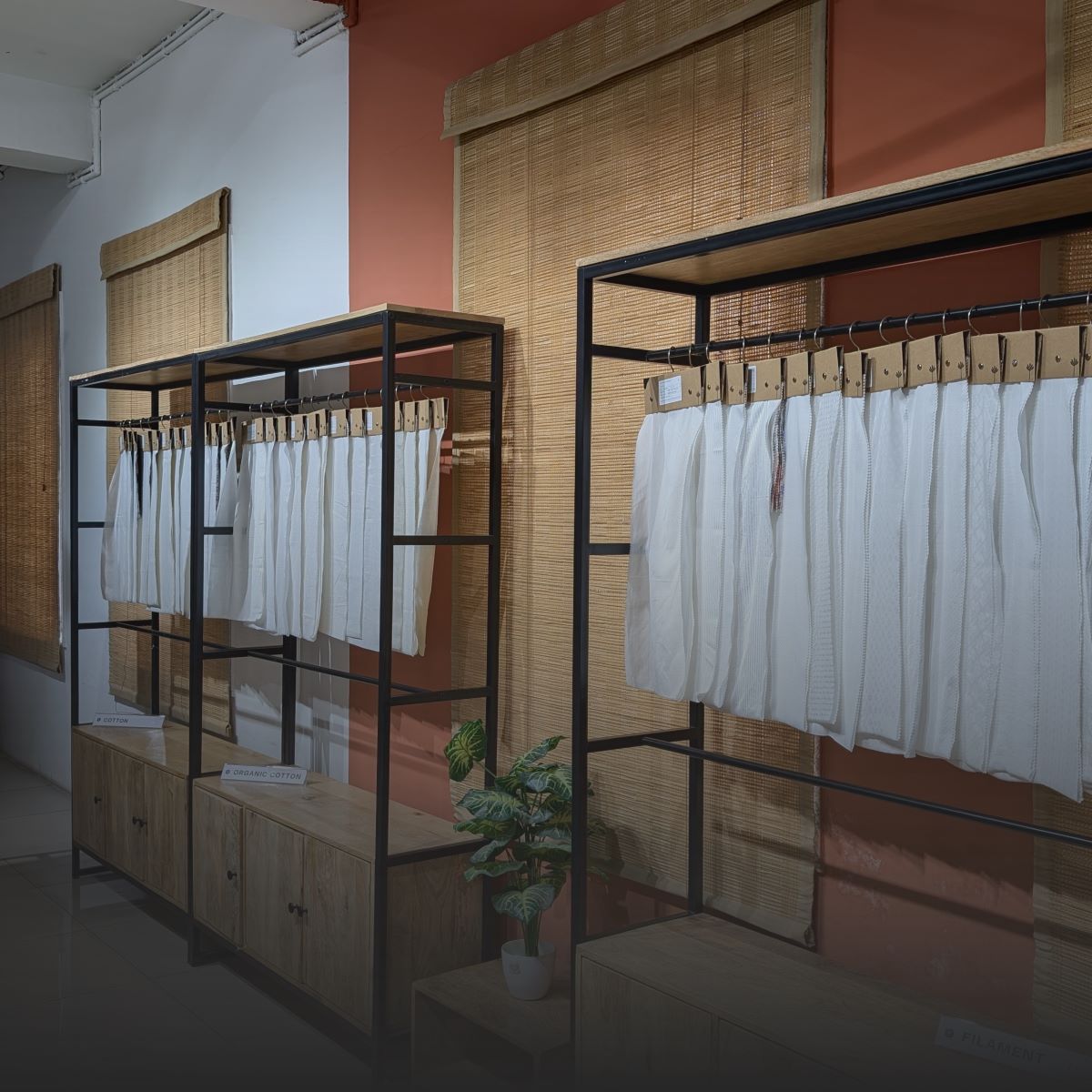Inventory and logistics that work well are not only important for operations; they are also necessary for any clothing manufacturing business to succeed.
In the fast-paced world of fashion and textiles, it's important to keep accurate records of inventory and make sure logistics work as planned to avoid running out of stock, production delays, and lost money. No matter if you're a new fashion brand or a wholesale clothing manufacturer in the USA, having a well-organized backend can help you grow quicker, save money, and confidently meet global demand.
What is Inventory Management in Garment Manufacturing?

Inventory management is the process of keeping track of, buying, storing, and using a business's finished and raw materials. In the clothing industry, it means managing:
- Raw materials (fabric, threads, zippers, buttons)
- Work-in-progress goods (half-stitched garments)
- Finished products ready for dispatch
Example: You need to keep track of how much denim fabric is used, how many buttons are needed, how many jackets are stitched, and how many are ready to ship if you're making 500 of them.
Also Read : The Ultimate Guide to Reducing Waste in Fabric Sourcing and Inventory Management
What is Logistics in Garment Manufacturing?

Logistics is the process of getting goods and materials from suppliers to factories, factories to warehouses, and warehouses to individuals who will buy them. In Simple words, logistics means how goods move—from:
- The fabric supplier to your factory,
- Your factory to the warehouse,
- Warehouse to the customer (retailers, wholesalers, or direct buyers).
Example: After you make the shirts, logistics helps you pack and send them to the right place at the right time, like a buyer in the USA or a store in Delhi.
Inventory And Logistics Management In Garment Manufacturing

It's important to keep good records of inventory and operations in the fashion business today, which is very competitive. You can cut down on waste, speed up production, and make sure you get good clothes on time with ERP, tagging systems, and real-time demand forecasts. Managing your inventory and transportation is important for making your business grow, whether you buy textiles from Fabriclore or make your clothes. Find out more:
1. Understand Demand Forecasting To Plan Inventory Accurately
Forecasting plays a crucial role in managing inventory. When brands lack data-driven demand prediction, they can either produce too much or not enough during busy times, which can negatively impact sales and trust in the brand.
How to forecast garment inventory needs:
- Analyze past sales data and current consumer trends.
- Use AI-powered tools or ERP systems like NetSuite or SAP for predictive insights.
- Coordinate with sourcing platforms like Fabriclore to plan raw material stock.
- Factor in seasonal fluctuations and fast-fashion cycles to adjust forecasts dynamically.
2. Choose the Right Inventory Strategy for Your Business Model
Every apparel manufacturer in the USA / India / Europe needs a specific stocking model. What works for fashion brands that sell a lot of clothes may not work for companies that create clothes for a single individual or sell directly to customers. Figuring out the optimal approach to do something can improve operational efficiency.
Popular inventory management methods:
- Just-in-Time (JIT): Receive raw materials only when needed to reduce holding costs.
- ABC Analysis: Classify inventory by importance—'A' being high-priority and high value.
- Economic Order Quantity (EOQ): Determine the optimal order quantity to minimize total inventory costs.
- Hybrid models: Combine buffer stock with JIT for better control in uncertain markets.
3. Digitize Inventory With Smart Technology Integration
For accuracy and scalability, digital tools are a must. A digital inventory system gives you real-time information, which lowers the risk of mistakes and keeps production from slowing down because of running out of stock.
Tools and technologies that help:
- ERP software (e.g., WFX, SAP, NetSuite) to centralize procurement, inventory, and production data.
- IMS (Inventory Management Systems) for barcoding, real-time tracking, and automatic stock updates.
- eCommerce integration to sync online and offline inventory for brands selling via D2C or marketplaces.
4. Structure And Store Fabrics Methodically For Faster Workflow
Fabric storage that isn't organized can cause mistakes, waste, and delays in production. A well-thought-out warehouse layout speeds up picking and keeps quality high while items are stored.
Fabric organization best practices:
- You can sort your items by fabric type (like cotton, silk, or mixes), GSM, or project type.
- First-In, First-Out (FIFO) can help you keep older stock from going bad.
- Set up different areas in your warehouse for new stock, WIP (Work In Progress), and finished goods.
- Use barcode or QR systems to label and tag things easily.
5. Strengthen Supplier Collaboration For Better Inventory Planning
Your ability to stick to production plans is directly linked to the network of suppliers you have. Building good relationships with suppliers lets you get things done faster and plan more easily.
How to optimize procurement with suppliers:
- Pick dependable fabric suppliers that are clear about their supply options, like Fabriclore.
- Plan for custom or seasonal sales.
- Use collaborative tools or supplier websites to keep an eye on changes to your inventory.
- Talk about MOQs and delivery times so that they work with your production processes.
6. Optimize Warehouse Operations For Speed And Accuracy
Your warehouse is an important part of the logistics chain, not just a place to store things. When things are organized, they get done faster, mistakes happen less often, and cloth care is better.
Improve warehousing with these steps:
- Set up Warehouse Management Systems (WMS) to keep track of your goods in real-time.
- Make sure your team knows how to handle delicate fabrics safely.
- Set up clear paths for picking up and loading fabric.
- Set up places for quality checks and return inspections.
7. Use Logistics Planning To Ensure Timely Deliveries
Logistics is about visibility, speed, and reliability. You must know where your shipment is, what's delayed, and how to act if something fails. This visibility boosts trust and reduces operational hiccups.
Ways to align logistics with manufacturing:
- Partner with people who can give you real-time tracking and ETA information.
- Use supply chain management tools to see how things are moving and get tips when there are problems.
- Prepare for busy times of the year by using different ways to move goods.
8. Adopt Sustainable Practices In Inventory And Shipping
Going green isn't just good for the environment; it's also good for business. Using sustainable inventory and transportation methods cuts down on wasted goods, lowers costs, and makes your business more eco-friendly.
Steps to integrate sustainability:
- Pick fabrics that are organic and ethically sourced.
- Use just-in-time (JIT) or on-demand creation.
- Use reusable or recyclable materials to cut down on packaging trash.
- Use carbon-neutral companies and combine loads to get the best shipping rates.
Why Inventory & Logistics Management Is Crucial In Apparel Production

When making clothes, accuracy and time are very important. Inventory management and logistics are important for making production run smoothly, from getting fabric to sending finished garments. If you don't handle these areas well, you could run out of stock, make too much, miss deadlines, and lose money in the end.
This is why they're important:
1. Avoid Overproduction and Deadstock
Manufacturers can keep track of raw materials and finished things at all times with good inventory management. It keeps people from buying too much fabric or trim, which often ends up as extra inventory that takes up space in warehouses and wastes money.
- Reduces material wastage
- Lowers holding costs
- Improves inventory turnover
2. Streamline Production Workflow
Cutting, stitching, and finishing all go easily when inventory is well-organized and in sync with production schedules. Delays caused by missing trims or not having enough fabric are cut down, which increases the number of on-time deliveries.
- Ensures raw material availability
- Supports faster turnaround
- Keeps production schedules on track
3. Enhance Demand Forecasting
Accurate inventory info helps with predicting sales. By looking at past sales and usage patterns, companies can better plan their production and meet demand that is driven by trends or the seasons.
- Enables smarter planning
- Reduces stockouts
- Increases customer satisfaction
4. Optimize Shipping and Delivery
Logistics is more than just sending finished clothes; it also means making sure that fabrics, trims, labels, and packaging arrive on time. Streamlining operations makes sure of the following:
- Just-in-time delivery of inputs
- Lower shipping costs through route optimization
- Better last-mile delivery to clients or warehouses
5. Boost Profitability
Every delay or waste of time costs money. By tightly controlling their inventory and operations, clothing companies can increase their profit margins by lowering costs, finding better materials, and losing less stock that doesn't sell.
- Minimizes financial risk
- Increases ROI
- Strengthens brand reliability
Fabriclore: Your Strategic Partner In Garment Manufacturing Sourcing

Fabriclore makes it easier for manufacturers to find the fabrics they need by providing a wide selection of Indian heritage and modern cotton fabrics that are perfect for a variety of clothing needs. Fabriclore helps clothing makers make better plans by giving them reliable transportation, custom printing, and real-time availability.
Why choose Fabriclore:
- There is a huge variety of fabrics like cotton, khadi, muslin, poplin, and more.
- Custom design printing options with low MOQ flexibility.
- Transparent sourcing from certified artisan clusters across India.
- Fast global shipping and restocking support to keep your production running.
Explore Fabriclore's Cotton Inventory Collection
Final Thoughts

In the ever-changing garment manufacturing industry, inventory and logistics management may make or break growth. Every step in handling raw materials, textiles, and completed goods affects manufacturing timelines and Profitability, from demand forecasts to stocking model selection. Your designs reach the market on time with efficient logistics and smart inventory techniques that reduce waste, overstocking, and lean operations.
Manufacturers can confidently scale their garment businesses by integrating digital technologies, creating strong supplier connections, and implementing sustainable practices. Fabriclore is a valued partner in modern fashion manufacturing due to its trustworthy sourcing, customization, and prompt deliveries.
Whether you're a startup or a scaled brand, investing in the right inventory and logistics strategies today sets the foundation for long-term success tomorrow.
Also Read: What are the best inventory management tools for your online fashion businesses?
FAQ's
Q1. Why Is Inventory And Logistics Management Important In Garment Manufacturing?
A: When clothes are being made, good inventory and logistics management keeps production running smoothly, cuts down on storage and waste costs, and makes sure that supplies happen on time. It stops common problems like running out of stock, making too much, and shipping late, which can all hurt your brand's image and revenue.
Q2. What Is Erp In Garment Manufacturing, And How Does It Improve Efficiency?
A: ERP, or Enterprise Resource Planning, is a centralized software system that helps clothing companies organize tasks like keeping track of inventory, buying things, planning production, and working with suppliers. Tools like SAP, WFX, Zoho Inventory, and NetSuite can help with accuracy and efficiency by automating tasks and giving real-time information.
Q3. How Does Demand Forecasting Help With Inventory Planning In Apparel Manufacturing?
A: Demand forecasting lets you figure out how much product you will need in the future by looking at past sales trends, seasonal demand, and how customers have behaved. This keeps you from having too much or too little stock, helps you plan your production better, and makes customers happier.
Q4. What Are The Benefits Of Using Barcoding In Garment Inventory Management?
A: Barcoding gives each roll of fabric or garment a unique number that can be scanned quickly and used to keep track of the type, quantity, and state of materials in real-time. This cuts down on mistakes made by hand and makes the list more accurate and clear.
Q5. Which Tools Are Best For Tracking Inventory In Garment Production?
A: ERP systems like NetSuite, SAP, and WFX Cloud, as well as spreadsheet-based programs like Excel, are some of the best tools for keeping track of inventory. These platforms allow for updates in real-time, make it easier to keep track of goods, and work with both production and sales systems without any problems.
Q6. What Are The Best Practices To Reduce Fabric Waste During Garment Production?
A: Use cutting optimization software, follow the First-In, First-Out (FIFO) rule for using raw materials, and only order fabric when you know exactly how much you will need and how to plan your production.
Q7. How Frequently Should Garment Manufacturers Perform Stock Audits?
A: Weekly stock checks and daily inventory updates help clothing companies stay accurate, avoid running out of materials, and prevent production delays caused by stock discrepancies.
Q8. How Can I Train My Staff For Efficient Inventory And Logistics Handling?
A: To keep things running smoothly and efficiently, teach your team how to use ERP and inventory management tools, keep records up to date, correctly label stock, and follow standard warehouse and handling procedures.
Q9. What Is The Best Way To Plan Logistics For On-Time Delivery Of Garments?
A: Plan your logistics around your production dates, use ERP systems to keep track of shipments, and plan for peak delivery times. Hire dependable transportation partners who can track your packages in real-time and give you clear updates on when they will arrive.
Q10. Where Can I Source High-Quality Fabric In Bulk With Fast Delivery Options?
A: Fabriclore has a wide selection of high-quality fabrics, such as cotton, muslin, khadi, and blends, that are carefully sourced from groups of artisans. Fabriclore is great for garment makers who need to find fabrics quickly and easily because they can see their inventory in real-time and ship goods all over the world.
We also happen to be a magnet for suggestions, and would love to catch yours….throw us yours on hello@fabriclore.com




